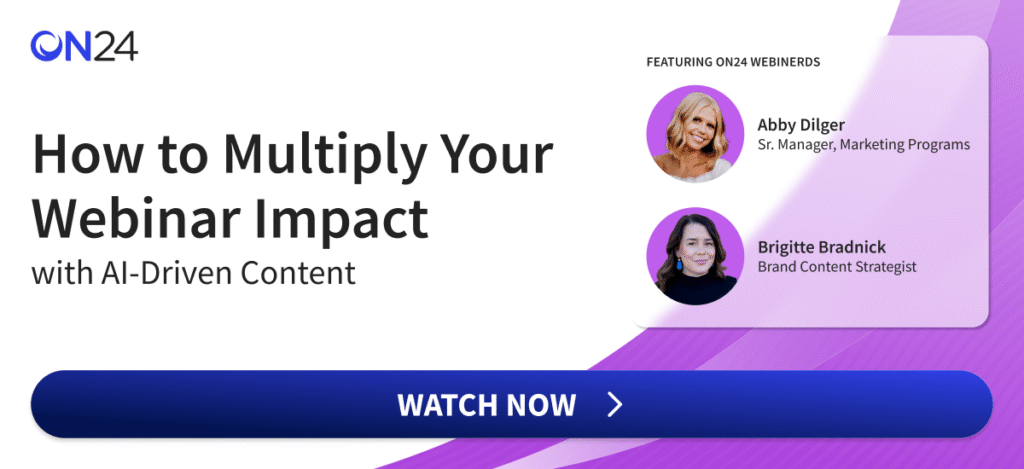Financial services marketing is changing fast. What worked just a few years ago is no longer enough to build trust, engage high-value clients and drive growth. As we look toward 2026, a new set of strategic priorities is emerging, driven by rapid advances in AI, shifting client expectations and persistent market pressures.
Staying ahead doesn’t just mean adopting new technology. It means integrating that technology with the two things that matter most in this industry: trusted data and human expertise.
To help you build your strategy, we’ve identified five key marketing trends financial services leaders need to prepare for.
1. AI solutions tailored to financial services become more prevalent
More than a decade ago, companies were already experimenting with Natural Language Generation (NLG) to create content and insights from financial services information.
In 2015, MIT Technology Review covered how T. Rowe Price and Credit Suisse were using software from Narrative Science to “write up in-depth, lengthy reports on the performance of mutual funds.”
Meanwhile, tech firm Automated Insights enabled The Associated Press (AP) to multiply coverage of corporate earnings by over tenfold. This had a real impact on the market, analysis by researchers at Stanford and the University of Washington found “compelling evidence” that these AP articles increased trading volumes and liquidity.
But the more recent AI boom has had a far greater impact. In 2023, Morgan Stanley announced it was partnering with OpenAI. By providing GPT-4 with its internal data, the firm’s wealth management division could “deliver relevant content and insights into the hands of financial advisors in seconds”. This was in addition to “an internally-built AI-based engine that delivers timely, customized messages to clients and prospects.”

AI technology vendors are now offering solutions specific to the needs of the financial services industry. As a result, the list of examples of professional services and financial services firms using AI has continued to grow.
| AI technology | Clients and uses for financial services |
| Claude by Anthropic | Big 4 firms, data providers and others are using Claude for applications such as:
Source: Anthropic |
| Gemini by Google |
Source: Google |
| Copilot by Microsoft |
Source: Microsoft |
What you can do
- Proactively speak to vendors and send Requests for Information (RFIs) to identify how they meet compliance and security requirements. Those serving the financial services industry answer requests related to compliance and security frequently. Getting details now will enable you to narrow down a growing list to suitable partners.
- Shortlist tools built for financial services marketers to reduce risk and accelerate implementation. Platforms such as ON24 meet the needs of financial services marketers without the complexity of large-scale digital transformation projects.
2. Trusted data becomes increasingly accessible to AI-powered agents
Within financial services, AI-powered solutions must be built on a foundation of high-quality, trusted data. This is essential as incorrect data not only has the potential to reduce client trust, but also may pose regulatory and compliance risks.
Indeed, a 2024 study by the Institute of International Finance and EY found that the top two challenges for deploying AI were data quality and data availability. This has become an issue as large language models (LLMs) have improved and developed reasoning capabilities, because an absence of reliable data limits their potential to generate actionable insights.
Fortunately for financial services marketers, access to high-quality data for use by AI-powered tools has increased markedly. Examples of note include:
- First-party data used by AI tools within martech platforms — Interaction data captured by ON24 is used by the AI-powered Analytics and Content Engine (ACE) to create video clips based on when engagement was highest.
- Customized knowledge based on defined data sources — Both Microsoft Copilot Studio and OpenAI Agents make it possible to tightly define exactly what data and knowledge can be used by an agent, even by those with limited technical knowledge.
- Model Context Protocol (MCP) Servers — These provide ready access to both internal and external data, sometimes from multiple sources. Snowflake’s MCP Server provides access to both internal proprietary data and third-party data from partners such as FactSet, MSCI, Nasdaq eVestment®, and The Associated Press.
Key terms
| Agentic AI | Evolving beyond AI chat, agentic AI refers to autonomous AI-powered systems that understand a goal, create a plan, and execute a series of tasks to deliver an output. Agents can integrate with different data sources and use external tools. This might include accessing financial data, internal content and front-end charting libraries to create dashboards and reports for clients. |
| Model Context Protocol (MCP) | An open-source standard for connecting AI applications and agents to external systems. Using MCP, agents can access data sources, tools and workflows that are offered by an MCP Server. More info at modelcontextprotocol.io |
What you can do
- Use AI-powered tools and data sources provided by your existing vendors to reduce deployment timelines and to take advantage of first-party data for AI-powered marketing.
- Maintain a “human-in-the-loop” with AI-enhanced processes to monitor quality and prevent inaccurate outputs being used for client-facing purposes.
3. Hyper-personalization becomes a key priority
While true personalization has long been an elusive goal for most banks due to data and technology complexity, the focus by 2026 will shift to using first-party data to power truly dynamic experiences. This is not just about using a client’s name or account in an email; it’s about delivering content and offers that adapt in real-time to their behavior and needs.
This priority is a result of two factors: client expectations and the potential offered by AI that uses first-party data and proprietary insights.
However, this opportunity comes with a significant risk. Research shows that while 91% of B2B marketers collect first-party data, nearly half (48%) have an immature governance strategy. Within regulated industries, this gap between data collection and data governance is a major liability, undermining both trust and compliance.
Why it matters
Getting personalization and governance right builds trust, deepens relationships, and drives revenue. BCG analysis shows that advisors using generative AI for personalization have seen significant performance improvements.
Effective AI models depend on diverse, accurate, and large datasets to develop hyper-personalized products and assess risk for different customer segments. Without a strong governance foundation, personalization efforts can quickly become inconsistent, noncompliant, or simply ineffective.

What you can do
- Move beyond basic personalization to dynamically changing content based on a visitor’s real-time behavior and past interactions with your brand.
- Map your first-party data sources — including demographic, behavioral, and contextual data from webinars and content hubs — to specific audience segments.
- Use analytics-driven audience targeting for high-value use cases like cross-selling, relationship deepening, and new customer onboarding.
Key stats and info
- Advisors using generative AI for personalization have seen a 5X increase in leads and a doubling of conversion rates. (Source: 2025 BCG Global Wealth Report)
- 72% of HNWIs prefer firms that offer highly personalized products and services. (Source: Capgemini World Wealth Report)
- Nearly 9 in 10 marketers (88%) plan to use AI to help with their personalization efforts. Personalizing calls-to-action within experiences can nearly double the attendee conversion rate for actions like ‘Book a Meeting.’ (Source: ON24 Personalization for Financial Services in the AI Era)
- The American Bankers Association lists “analytics-driven audience targeting” as a key trend, second only to the related issue of “cross-sell and relationship deepening”. (Source: ABA Bank Marketing Trends)
4. Human experts will continue to power authentic thought leadership
While AI can generate vast quantities of content, true thought leadership and trusted advice — the kind that builds authority, differentiates from others, and earns trust — comes from human expertise. Even as AI and technology extends the potential for financial services providers to serve clients, building genuine connections will require a human-in-the-loop.
Why it matters
While commoditized financial services have increasingly become automated with no human involvement, clients at the higher end place a premium on personal advice. This means that putting experts and staff at the center of marketing efforts is essential.
When financial services clients are able to easily find another provider, the ability to surface a unique point of view and offer is a critical business differentiator. Authentic expertise, delivered by real people, cuts through the noise and builds the long-term trust that drives business relationships.
For advisor enablement, educational content delivered by people has increasingly been sought out. Since 2021, the number of certifications issued through the ON24 platform has increased by 58%.
While financial services marketers should use technology to scale and improve customer experiences, they should do so by scaling the reach of their experts.

What you can do
- Feature your experts prominently in live, interactive digital experiences such as webinars, where they can answer questions and build direct relationships with your audience.
- Identify interested clients for outreach by using first-party engagement data from digital experiences.
- Amplify the reach of your experts by repurposing and promoting their content and expertise across channels, using AI to turn assets in one format into another.
Key stats and info
- Globally, 60% of wealth management clients expected their advisors to use AI. (Source: EY 2025 Global Wealth Report).
- 80% of affluent households are willing to pay a premium for human advice rather than an exclusively digital service. (Source: McKinsey)
- For clients seeking investment advice in the UK, 34% are open to human advisors using AI tools, but only 6% would rely on an AI platform alone. (Source: Unbiased)
- The average attendance length for financial services webinars increased by 6%, while meeting bookings within webinars rose 26%. (Source: 2025 Financial Services Digital Engagement Benchmarks).
5. Repurposed content becomes key to expanding reach under revenue pressures
Even with many positive market indicators in 2025, financial services firms are under pressure. Analysis by McKinsey shows that despite double-digit growth in global revenues and global assets under management (AUM) reaching record highs, profitability has only seen marginal single point growth. A 2025 report from BCG noted that 70% of 2024 revenue growth for asset managers came from market performance, not new inflows, highlighting the need for operational efficiency. Creating new, compliance-heavy content from scratch is slow and expensive.
For financial services marketers, this means that 2026 will require even greater levels of efficiency to achieve their goals.
Fortunately, AI-powered content repurposing offers an opportunity to drive increased results from existing efforts. This strategy of taking one high-value, long-form asset — like a webinar, research report or white paper — and transforming it into multiple smaller assets provides the potential to multiply marketing impact. This allows you to create blog posts, social media updates, video clips, infographics and newsletter articles from a single, compliance-approved source.
Why it matters
Financial services firms, particularly in asset and wealth management, face significant revenue and cost pressures. Repurposing allows you to maximize the ROI on your core thought leadership, save resources, reinforce your key messages and reach a broader audience on different channels.
What you can do
- Start with high-value, expert-led source material as the foundation for repurposed content. Formats such as interviews, webinars or podcasts can be particularly effective, ensuring any repurposed content is built around the human expertise that clients trust. For a step-by-step guide, download the Campaign-in-a-Box Blueprint.
- Use AI-powered tools to automatically generate transcripts, summaries, blog posts and e-books from your webinar content.
- Use first-party engagement data and analytics to identify what content resonates with your target audience. Use this to prioritize the themes and angles to lead with.
Key stats and info
- “Operational efficiency” and “revenue growth” are the top two technology drivers for asset and wealth management professionals. (Source: PwC Asset and Wealth Management Survey)
- AI is dramatically accelerating content processes, with campaign time-to-market falling by 50% while content creation time is 30% lower. (Source: Bain & Company)
- 60% of B2B marketers state that using AI for promotional content is a key priority. (Source: The State of AI in B2B Marketing)
Conclusion: success in 2026 will come from using technology to strengthen trust
The trends shaping 2026 — from tailored AI and trusted data to hyper-personalization and authentic thought leadership — all point to a single goal: building and maintaining client trust in a digital-first world. By focusing your strategy on these pillars, you can cut through the noise, build deeper relationships and drive real revenue growth.
See how the ON24® platform can help you power your financial services marketing strategy. Learn more about our solutions for financial services.




